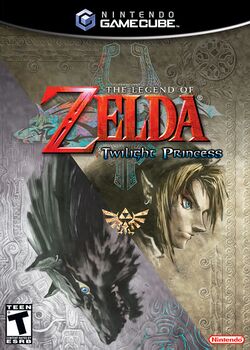Welcome to the new Mariopedia!
The Legend of Zelda: Twilight Princess
It has been requested that this article be rewritten.
| The Legend of Zelda: Twilight Princess | |||||||||||||
 Wii cover art  Nintendo GameCube cover art | |||||||||||||
| Developer | Nintendo EAD | ||||||||||||
| Publisher | Nintendo | ||||||||||||
| Platform(s) | Wii, Nintendo GameCube | ||||||||||||
| Release date | Wii: Nintendo GameCube: | ||||||||||||
| Genre | Action-adventure | ||||||||||||
| Rating(s) |
| ||||||||||||
| Mode(s) | Single player | ||||||||||||
| Media | GameCube:
Wii: | ||||||||||||
| Input | Nintendo GameCube: Wii:
| ||||||||||||
The Legend of Zelda: Twilight Princess is the thirteenth installment of the main The Legend of Zelda series. It is an action-adventure game developed by Nintendo's EAD division and published by Nintendo themselves for the Wii and Nintendo GameCube in late 2006. Nearly ten years later, in 2016, a remake was released for the Wii U, titled The Legend of Zelda: Twilight Princess HD.
The Legend of Zelda: Twilight Princess was first revealed in the form of a trailer at E3 2004. Playable demos were featured at E3 2005 and E3 2006, the former of which had a The Legend of Zelda: Twilight Princess Preview Trailer, which participants could watch on their Nintendo DS from either a cartridge or via DS Download Play.
Originally planned for release in November 2005, The Legend of Zelda: Twilight Princess was delayed so that Nintendo EAD could add in more content and refine the game. The Wii and Nintendo GameCube versions were released around the same time, the former console having it as a launch title and the latter conversely having it as the last first-party release. The Wii and Nintendo GameCube versions are largely similar, with the main difference being that the maps are mirrored. The Wii version is also the first game in which Link is right-handed, which was to make swinging the Wii Remote to make Link move his sword more realistic.
The game's story focuses on Link as he tries to prevent the Twilight Realm from engulfing Hyrule. He takes the form of a Hylian as well as a wolf, and is met with the help of a mysterious imp named Midna.
The Legend of Zelda: Twilight Princess is the first The Legend of Zelda game that is a launch title, and is also the first to receive a T rating from the ESRB, for fantasy violence and animated blood.
Reception
The game received high praise from critics, earning perfect scores from many major gaming publications, with many reviewers hailing it as the greatest The Legend of Zelda game, and one reviewer even described Twilight Princess as "the single greatest video game experience". It won many "Game of the Year" awards for 2006, and IGN gave it the awards for Best Artistic Design, Best Original Score, Best Use of Sound, Best Graphics and Best Story. Nintendo Official Magazine placed Twilight Princess at number 16 in their list of the 100 Greatest Nintendo Games of All Time. On the other hand, some have criticized the game for often being blurry, which is due to the fact that the Wii is the only seventh generation console not to support HD graphics, and others have said that, while the idea of swinging the Wii remote to make Link swing his sword is a good one, the controls simply aren't immersive enough. This would be rectified in The Legend of Zelda: Skyward Sword, which uses the Wii Motion Plus to translate every single movement of the Wii Remote into a movement of Link's sword.
Trivia
- The Legend of Zelda: Twilight Princess was called "The Wind Waker 2" early in its development cycle.[citation needed]
 This The Legend of Zelda-related article is a stub. You can help Mariopedia by expanding it.
This The Legend of Zelda-related article is a stub. You can help Mariopedia by expanding it.